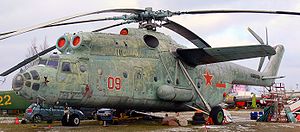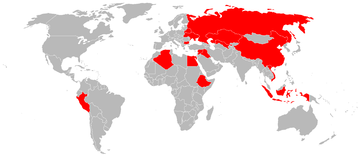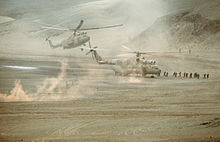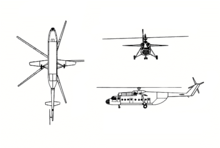- Mil Mi-6
-
Mi-6 Mi-6 at Riga, Latvia. Role Heavy transport helicopter Manufacturer Mil Moscow Helicopter Plant First flight 5 September 1957[1] Introduction 1962 Retired 2002 (Russia CAA) Status In service with foreign users Primary users Soviet Air Force
AeroflotProduced 1960 to 1981[2] Number built 925+ Variants Mil Mi-10 The Mil Mi-6 (NATO reporting name Hook) was a Soviet/Russian heavy transport helicopter designed by the Mil design bureau and built in large numbers for both military and civil roles.
Contents
Design and development
The Mi-6 was first flown in September 1957. Getting this large vehicle in the air is no easy task; the Mi-6 has an enormous gearbox, heavier than its engines, and often uses short wings to relieve the load on the rotor in cruise. Not only was it for a long time the largest helicopter in the world, it was also the fastest with a speed of 300 km/h. Its maximum load capacity is 12,000 kg.
When designed in 1954-56 it was by far the largest in the world, and even today its dynamic components of engines, gearbox, rotors and drive shafts are considered state-of-the-art. In its early days this helicopter set many world records, including one for sheer circuit speed at over 211 mph (340 km/h). In 1959-72 a total production of at least 500 were built for various general transport, utility, firefighting and flying-crane duties, the last two sub-types not being fitted with the large fixed wings which in other versions bear part of the lift in cruising flight and thus enable higher speeds to be attained. The twin nose wheels and large low-pressure main wheels do not retract. Normally flown by a crew of no fewer than five, the Mi-6 seats 65 armed troops and can alternatively carry 41 stretcher (litter) patients and two attendants, or a wide range of bulky loads, including vehicles, loaded through rear clamshell doors. In exercises fleets of these aircraft have airlifted many kinds of weapons, including FROG-7 rockets on their PT-76 tracked chassis, as well as large radars and heavy artillery. All Soviet APCs (Armoured personnel carriers), armoured cars and light MICVs (mechanised infantry combat vehicles) can be carried.
The CIS Interstate Aviation Committee cancelled the Mi-6's Type Certificate in October 2002 after the crash of RA-21074 in the Taimyr Pennisula.[3] There have also been reports that the wooden tail rotor blades[4] have reached the end of their service life.
Variants
- V-6 : (Zavod No.329 Moscow) First prototype series.
- Mi-6 (NATO - Hook-A) : Heavy-lift transport helicopter.
- Mi-6A : Civil transport helicopter, with accommodation for between 65 and 90 passengers.
- Mi-6T (NATO - Hook-A) : Military transport helicopter, which can seat up to 70 people on tip-up seats along the cabin sides, with additional seat along the center-line.
- Mi-6VKP (NATO - Hook-B) : Command post, electronic warfare helicopter.
- Mi-6BUS (NATO - Hook-C) : (Also Mi-6AYa and Mi-22) airborne command post helicopter of 1975.
- Mi-6AYaSh (NATO - Hook-D) : (Also Mi-6VUS and Mi-6VzPU) airborne command post with SLAR.
- Mi-6L : (Also Mi-6LL: Letayushchaya laboratoriya) Flying laboratory variant with D-25VF engines used for flight improvements of the Mi-6 and testbed for the powerplant of the Mi-12.
- Mi-6M : Anti-submarine variant armed with four aerial torpedoes and ASW rockets, and equipped with various experimental ASW systems. First built in 1963 and modified in 1965 for the "Barge Hauler" program.
- Mi-6P : Passenger transport helicopter, with accommodation for approximately 80 passengers.
- Mi-6PP : Electronic reconnaissance and AWAC detection jammer developed in the 1980s.
- Mi-6PR : (Protivodeystviya Radiorazvedke) Development in 1962 for jammer/electronic warfare variant.
- Mi-6PRTBV : A few modified as mobile rocket/technical bases and rocket fuel transports.
- Mi-6PS : Search and rescue helicopter developed in 1966 for pick-up of the landed "Vostok" and "Soyuz" space modules.
- Mi-6PSA : Little-known modification similar to Mi-6PS.
- Mi-6PZh and Mi-6PZh2 : .
- Mi-6R : (Retranslyator) specialised radio communications variant developed in 1974.
- Mi-6RVK : Tested in 1965 armed with mobile missile launchers.
- Mi-6S : Medical evacuation helicopter, which can carry up to 41 litters.
- Mi-6TP : Convertible freight/passenger helicopter.
- Mi-6TZ : (Also Mi-6ATZ) fuel transport helicopter.
- Mi-6VR "Vodoley" : Experimental Mi-6 developed in 1976 for testing helicopter de-icing systems and for testing the rotor system of the Mi-26.
- Mi-6? : Developed in 1962 with collapsable BU-75BRM drilling rig for oil exploration in Siberia. Exact designation unknown.
Operators
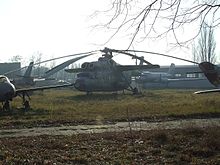 Ex-Polish Air Force Mi-6 exhibited at Lublinek airfield near Łódź.
Ex-Polish Air Force Mi-6 exhibited at Lublinek airfield near Łódź.
Military Operators
- Afghan Air Force
- Belarus Air Force
- Bulgarian Air Force - retired.
- Polish Air Force — operated three in 1986–1990; two sold to Ukraine, one exhibited at museum[5]
- Soviet Air Force
- Soviet Army Aviation
- Soviet Naval Aviation — passed on to successor states
- Vietnamese Air Force
- Zimbabwe Air Force
Civil operators
- Construction firms (Instal and Elbud) operated three Mi-6A in 1974-1985[5].
Specifications (Mi-6)
Data from Jane's All The World's Aircraft 1992-93[6]
General characteristics
- Crew: 6 (pilot, copilot, navigator, flight engineer, radio operator, technician)
- Capacity:
- 90 passengers or
- 70 airborne troops or
- 41 stretcher cases with 2 medical personnel or
- up to 12,000 kg (26,400 lb) of internal cargo
- Length: 33.18 m (108 ft 10 in)
- Rotor diameter: 35.00 m (114 ft 10 in)
- Height: 9.86 m (32 ft 4 in)
- Disc area: 962.1 m² (10,356 ft²)
- Empty weight: 27,240 kg (60,055 lb)
- Loaded weight: 40,500 kg (89,285 lb)
- Max takeoff weight: 42,500 kg (93,700 lb)
- Powerplant: 2 × Soloviev D-25V turboshafts, 4,100 kW (5,500 shp) each
- Fuel load: 6,315 kg (13,922 lb)
Performance
- Maximum speed: 300 km/h (162 kt)
- Cruise speed: 250 km/h (135 kt)
- Range: 620 km (385 miles)
- Ferry range: 1,450 km (900 miles)
- Service ceiling: 4,500 m (14,750 ft)
- Disc loading: 44.17 kg/m² (9.05 lb/ft²)
- Power/mass: 0.21 kW/kg (0.13 hp/lb)
Facts
- Test pilot N.B. Leshin has set the world record of speed. This event was awarded by the American Helicopter Society.
- Small numbers are still in service, most in Siberia plus a small number with the People's Republic of China. The Russian Air Force currently operates 5 Mi-6s.
- Several contaminated Mi-6s can be found with the thousands of other pieces of equipment in the "vehicle graveyards" in the Chernobyl disaster alienation zone.
See also
- Related development
- Aircraft of comparable role, configuration and era
- CH-54 Tarhe / S-64 Skycrane
- CH-53 Super Stallion
- CH-47 Chinook
- Aérospatiale Super Frelon
References
- ^ Mil Mi-6 helicopter - development history, photos, technical data
- ^ Mil Heavy-Lift Helicopters
- ^ Gordon 2005
- ^ Gordon 2005
- ^ a b Wacław Hołyś, Największy i najszybszy (Biggest and fastest) in Wiraże nr.6/2005, p.27. (Polish)
- ^ Mark Lambert, ed (1992). Jane's All The World's Aircraft,1992-93. COulsdon, Surrey, UK: Jane's Information Group. ISBN 0-7106-0987-6.
- Bibliography
- Gordon, Yefim, Komissarov, Dmitriy and Komissarov, Sergey, Mil's Heavylift Helicopters; Mi-6/Mi-10/V-12/Mi-26, Red Star Volume 22, Midland Counties Publications, 2005
External links
Mil aircraft Lists relating to aviation General Aircraft (manufacturers) · Aircraft engines (manufacturers) · Airlines (defunct) · Airports · Civil authorities · Museums · Registration prefixes · Rotorcraft (manufacturers) · TimelineMilitary Accidents/incidents Records The initial version of this article was based on material from aviation.ru. It has been released under the GFDL by the copyright holder.
Categories:- 1957 introductions
- Military helicopters
- Mil aircraft
- Soviet cargo aircraft 1950–1959
- Soviet military transport aircraft 1950–1959
- Soviet helicopters 1950–1959
Wikimedia Foundation. 2010.

